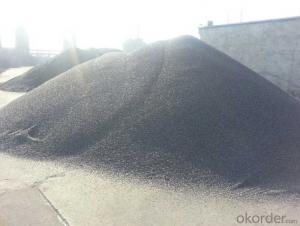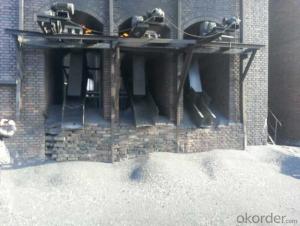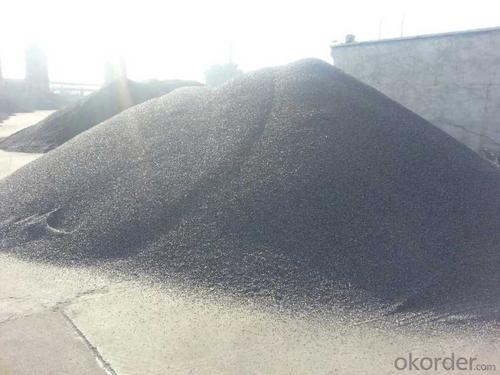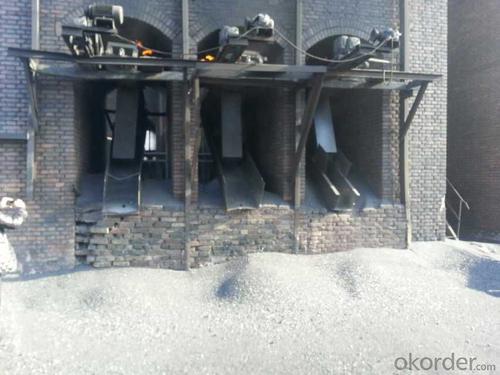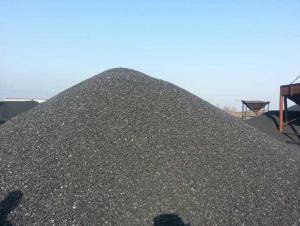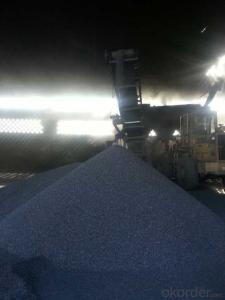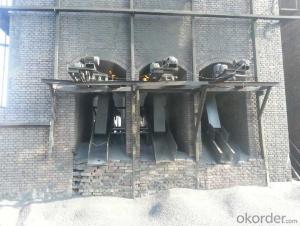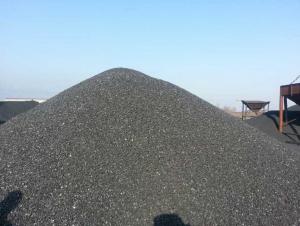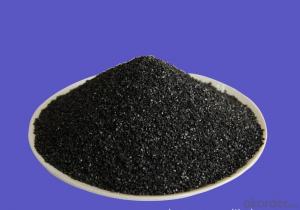Gas Calcined Anthracite FC90-95 with stable quality
- Loading Port:
- Tianjin
- Payment Terms:
- TT OR LC
- Min Order Qty:
- 20 m.t.
- Supply Capability:
- 3000 m.t./month
OKorder Service Pledge
OKorder Financial Service
You Might Also Like
Packaging & Delivery
25kgs/50kgs/1ton per bag or as buyer's request
Specifications
Calcined Anthracite
Fixed carbon: 90%-95%
S: 0.5% max
Size: 0-3. 3-5.3-15 or as request
It used the high quality anthracite as raw materials through high temperature calcined at over 2000 by the DC electric calciner with results in eliminating the moisture and volatile matter from anthracite efficiently, improving the density and the electric conductivity and strengthening the mechanical strength and anti-oxidation. It has good characteristics with low ash, low resistvity, low sulphur, high carbon and high density. It is the best material for high quality carbon products.
Advantage and competitive of caclined anthracite:
1. strong supply capability
2. fast transportation
3. lower and reasonable price for your reference
4.low sulphur, low ash
5.fixed carbon:95% -90%
6..sulphur:lower than 0.3%
General Specification of Calcined Anthracite:
| FC | 95 | 94 | 93 | 92 | 90 |
| ASH | 4 | 5 | 6 | 6.5 | 8.5 |
| V.M. | 1 | 1 | 1 | 1.5 | 1.5 |
| S | 0.3 | 0.3 | 0.3 | 0.35 | 0.35 |
| MOISTURE | 0.5 | 0.5 | 0.5 | 0.5 | 0.5 |
Pictures
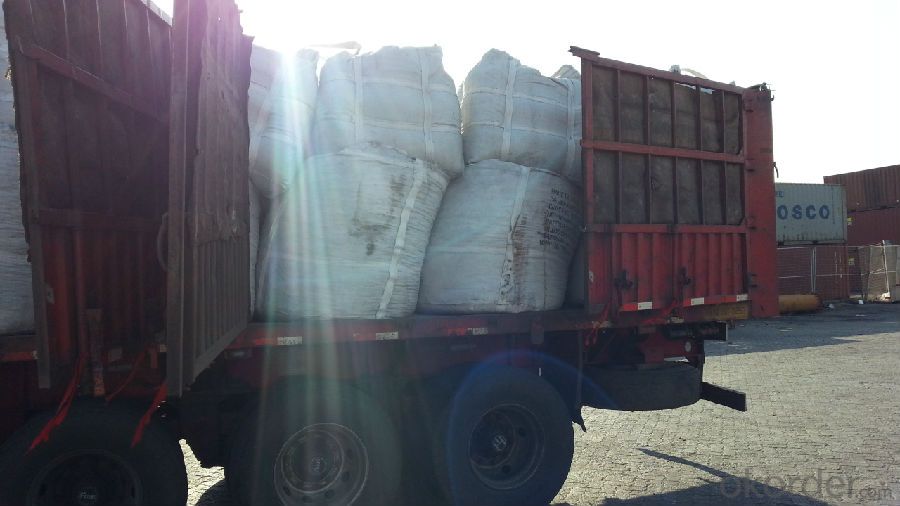
We are also strong at below materials, please contact us if you are interested in any of them:
Calcined Petroleum Coke
Carbon Electrode Paste
Carbon Electrode
- Q: What is the chemical symbol for carbon?
- C is the designated chemical symbol for carbon.
- Q: What is a carbon free martensite?
- The definition of martensite of Fe based alloy (solid steel and other iron-based alloy) and non ferrous metals and alloys, is guetche variant diffusion free phase transition product of martensitic transformation. It is a product of Fe based alloy, phase transformation of undercooled austenite occurs without diffusion were guetche formation of martensite variant body transformation.
- Q: What are the applications of carbon nanomaterials in medicine?
- Due to their unique properties and potential applications, carbon nanomaterials have emerged as promising tools in the field of medicine. One key application of these nanomaterials is in drug delivery systems, where they can be functionalized with drugs for targeted delivery to specific cells or tissues. The large surface area of carbon nanomaterials allows for more efficient drug loading, leading to improved therapeutic efficacy and reduced side effects. In the field of tissue engineering, carbon nanomaterials show great potential as scaffolds for supporting the growth and regeneration of damaged tissues. Their excellent mechanical strength and biocompatibility make them suitable for applications like bone and cartilage repair. Additionally, their electrical and thermal conductivity properties make them ideal for creating bioelectrodes and biosensors, which can be used for various diagnostic and monitoring purposes. Furthermore, carbon nanomaterials have been investigated for their antimicrobial properties. They have demonstrated the ability to inhibit the growth of bacteria and fungi, making them potential candidates for developing new antimicrobial agents. This could be particularly beneficial in preventing and treating infections in medical devices and implants. Another application of carbon nanomaterials in medicine is in imaging and diagnostics. These nanomaterials can serve as contrast agents in imaging techniques like magnetic resonance imaging (MRI) and fluorescence imaging. Their unique optical and magnetic properties enable enhanced imaging and improved disease detection, such as in cancer. Carbon nanomaterials also hold promise in the field of cancer therapy. They can be utilized in photothermal therapy, where they convert light into heat and selectively kill cancer cells. Additionally, they can be used in photodynamic therapy, where light activation triggers the generation of reactive oxygen species, leading to the destruction of cancer cells. In conclusion, carbon nanomaterials have a wide range of applications in medicine, including targeted drug delivery, tissue engineering, antimicrobial agents, diagnostic imaging, and cancer therapy. Ongoing research and development in this field have the potential to revolutionize medical treatments and enhance patient outcomes.
- Q: What are the effects of carbon emissions on the stability of mountains?
- The stability of mountains is significantly impacted by carbon emissions, leading to various negative consequences. One of the primary effects is the accelerated melting of glaciers and ice caps, caused by global warming resulting from carbon emissions. Rising temperatures cause the ice and snow that hold mountains together to melt, resulting in increased instability. This melting can lead to more frequent and larger avalanches, landslides, and rockfalls, posing a significant threat to human settlements and ecosystems in mountainous areas. Another consequence of carbon emissions on mountain stability is the alteration of precipitation patterns. As the climate changes, rainfall becomes more unpredictable, resulting in a higher frequency of intense rainfall events. This increased rainfall can cause soil erosion and weaken the stability of mountain slopes. The combination of increased erosion and weakened slopes can lead to landslides and other mass movements, further destabilizing mountains. Furthermore, carbon emissions contribute to the acidification of rainwater, which can have detrimental effects on mountain stability. Acid rain erodes rocks and soil, making them more susceptible to weathering processes. This weakening of the geological structure increases the likelihood of landslides and rockfalls. Lastly, carbon emissions also impact mountain stability through their influence on ecosystems and biodiversity in mountainous regions. Climate change caused by carbon emissions can lead to shifts in ecosystems and biodiversity, affecting the stability and resilience of mountain ecosystems, as well as altering vegetation cover patterns. The loss of vegetation cover, for example, further increases the susceptibility of slopes to erosion and landslides. In conclusion, carbon emissions have a range of negative effects on mountain stability. From accelerated glacier melting to altered precipitation patterns, acid rain, and shifts in ecosystems, these emissions pose a significant threat to the geological and ecological stability of mountains. It is crucial to reduce carbon emissions and address climate change to mitigate these effects and preserve the stability of mountain regions.
- Q: How is activated carbon produced?
- Activated carbon is produced through a process called activation, which involves heating carbon-rich materials, such as wood, coal, or coconut shells, at high temperatures in the absence of oxygen. There are two main methods of activation: physical activation and chemical activation. In physical activation, the carbon-rich material is first carbonized by heating it to a high temperature. This creates a carbonized char with a high carbon content. The char is then treated with an oxidizing gas, such as steam or carbon dioxide, at temperatures between 600 to 900 degrees Celsius. This causes the char to expand and develop a highly porous structure. The resulting material is then washed and dried to remove any impurities, resulting in activated carbon. Chemical activation, on the other hand, involves impregnating the carbon-rich material with a chemical activating agent, such as phosphoric acid, zinc chloride, or potassium hydroxide. The impregnated material is then heated to temperatures ranging from 400 to 800 degrees Celsius. This process chemically reacts with the carbon, creating a highly porous structure. The activated carbon is then washed and dried to remove any residual chemicals. Both physical and chemical activation methods result in the production of activated carbon with a large surface area and a network of pores. These pores enhance the adsorption capacity of the activated carbon, allowing it to effectively trap and remove impurities, contaminants, and pollutants from gases and liquids.
- Q: How does carbon impact the formation and intensity of hurricanes?
- Carbon dioxide (CO2) and other greenhouse gases contribute to the warming of the Earth's atmosphere, leading to global climate change. This increased warming affects the formation and intensity of hurricanes. Warmer ocean temperatures provide more energy for hurricanes to form and strengthen, making them more intense. Additionally, higher levels of atmospheric moisture due to increased evaporation from warmer oceans also contribute to the formation and intensity of hurricanes. Therefore, carbon emissions play a significant role in the impact of hurricanes by fueling their formation and increasing their destructive potential.
- Q: What are the effects of carbon emissions on the stability of the atmosphere?
- Carbon emissions have significant effects on the stability of the atmosphere. Increased levels of carbon dioxide and other greenhouse gases contribute to the greenhouse effect, trapping heat within the atmosphere and leading to global warming. This results in various consequences such as rising temperatures, changes in weather patterns, melting ice caps, and rising sea levels. These alterations disrupt the delicate balance of the atmosphere, causing severe environmental and ecological impacts, including more frequent and intense extreme weather events. Ultimately, carbon emissions threaten the stability of the atmosphere and the overall health of our planet.
- Q: What should I do when carbon monoxide leaks?
- Be careful not to let their affected by the cold, otherwise, may make the body temperature decreased cardiac arrest. If the poisoned person can drink, can feed the hot tea and sugar, to keep warm, cold towel head can not be used, but can not pour cold water. Poisoning breathing difficulties or just stop breathing, artificial respiration should be immediately closed chest cardiac massage or first aid, and to call the ambulance the unit, or ask the neighbors to help, send the patient to the hospital for treatment.
- Q: What is carbon offsetting in the hospitality industry?
- The hospitality industry engages in carbon offsetting as a means of counteracting the greenhouse gas emissions generated by hotels, resorts, and other businesses in the sector. This practice serves to offset the carbon footprint resulting from various activities within the industry, including energy consumption, transportation, waste management, and water usage. To engage in carbon offsetting, hospitality establishments first calculate the quantity of carbon dioxide or other greenhouse gases they emit. They then invest in projects aimed at reducing emissions in other locations. Examples of such projects include initiatives focused on renewable energy, reforestation, or energy efficiency. Through supporting these projects, the hospitality industry strives to offset or neutralize its own carbon emissions and thereby minimize its impact on climate change. Hotels and resorts have the option to purchase carbon offsets from specialized organizations that facilitate carbon offset projects. These organizations ensure that the offsets are verified and adhere to recognized standards, such as the Verified Carbon Standard or the Gold Standard. By investing in verified offsets, the hospitality industry can have confidence that their contributions effectively contribute to reducing global greenhouse gas emissions. Carbon offsetting in the hospitality industry not only showcases environmental responsibility but also offers economic advantages. A growing number of travelers are increasingly conscious of the environmental consequences associated with their accommodation choices. As a result, they actively seek out hotels and resorts that prioritize sustainability. By implementing carbon offsetting programs, hospitality businesses can attract environmentally conscious guests and stand out in a competitive market. Moreover, carbon offsetting is just one component of a wider sustainability strategy within the hospitality industry. Many hotels and resorts are also adopting energy-efficient practices, implementing waste reduction measures, and promoting water conservation. By combining these efforts with carbon offsetting initiatives, the hospitality industry can contribute to a more sustainable future while simultaneously improving their financial performance. In conclusion, carbon offsetting in the hospitality industry involves investing in projects that reduce greenhouse gas emissions in order to compensate for the carbon footprint generated by hotels and resorts. This practice enables the industry to nullify its environmental impact and demonstrate a commitment to sustainability. Through the implementation of carbon offsetting programs, the hospitality industry can attract environmentally conscious guests, differentiate itself in the market, and contribute to a more sustainable future.
- Q: How are carbon nanotubes produced?
- Carbon nanotubes are produced through a process called chemical vapor deposition (CVD), which involves the use of a carbon-containing gas and a catalyst. In this process, a substrate is coated with a catalyst material, usually iron, nickel, or cobalt. The substrate is then placed in a high-temperature furnace, typically around 800-1000 degrees Celsius, and exposed to a carbon-containing gas, such as methane or ethylene. As the gas decomposes at high temperatures, carbon atoms are released and deposited onto the catalyst nanoparticles on the substrate. These carbon atoms then arrange themselves in a hexagonal pattern, forming a tube-like structure, which grows vertically from the catalyst particles. The growth of the nanotubes is driven by the difference in carbon solubility between the catalyst and the growing tube. The diameter, length, and alignment of the carbon nanotubes can be controlled by adjusting various parameters such as the temperature, gas flow rate, and catalyst material. By manipulating these parameters, researchers can produce carbon nanotubes with specific characteristics suitable for various applications. It's worth noting that there are other methods to produce carbon nanotubes, such as arc discharge and laser ablation, but CVD is the most commonly used method due to its scalability and ability to produce large quantities of nanotubes. Additionally, CVD allows for the growth of vertically aligned nanotube arrays, which are highly desirable for many applications.
Send your message to us
Gas Calcined Anthracite FC90-95 with stable quality
- Loading Port:
- Tianjin
- Payment Terms:
- TT OR LC
- Min Order Qty:
- 20 m.t.
- Supply Capability:
- 3000 m.t./month
OKorder Service Pledge
OKorder Financial Service
Similar products
Hot products
Hot Searches
Related keywords
